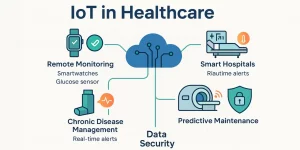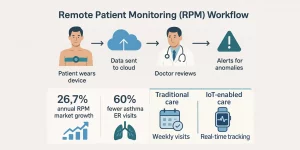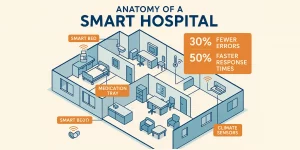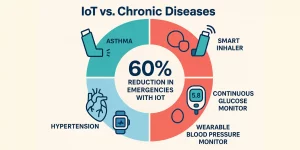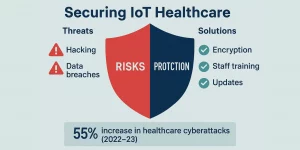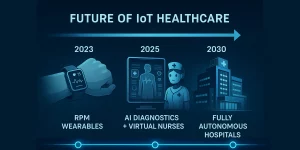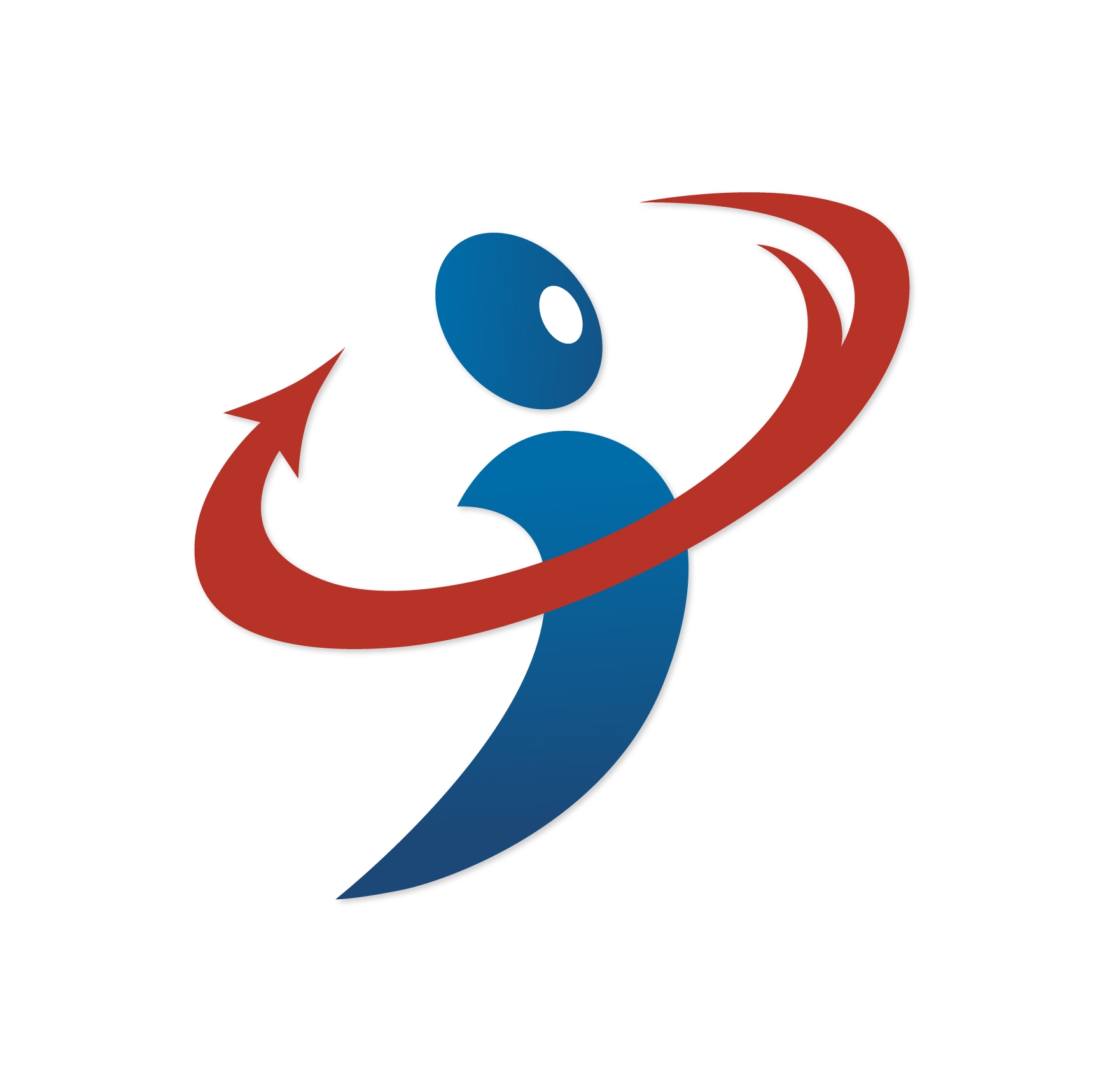How IoT Is Transforming the Healthcare Sector
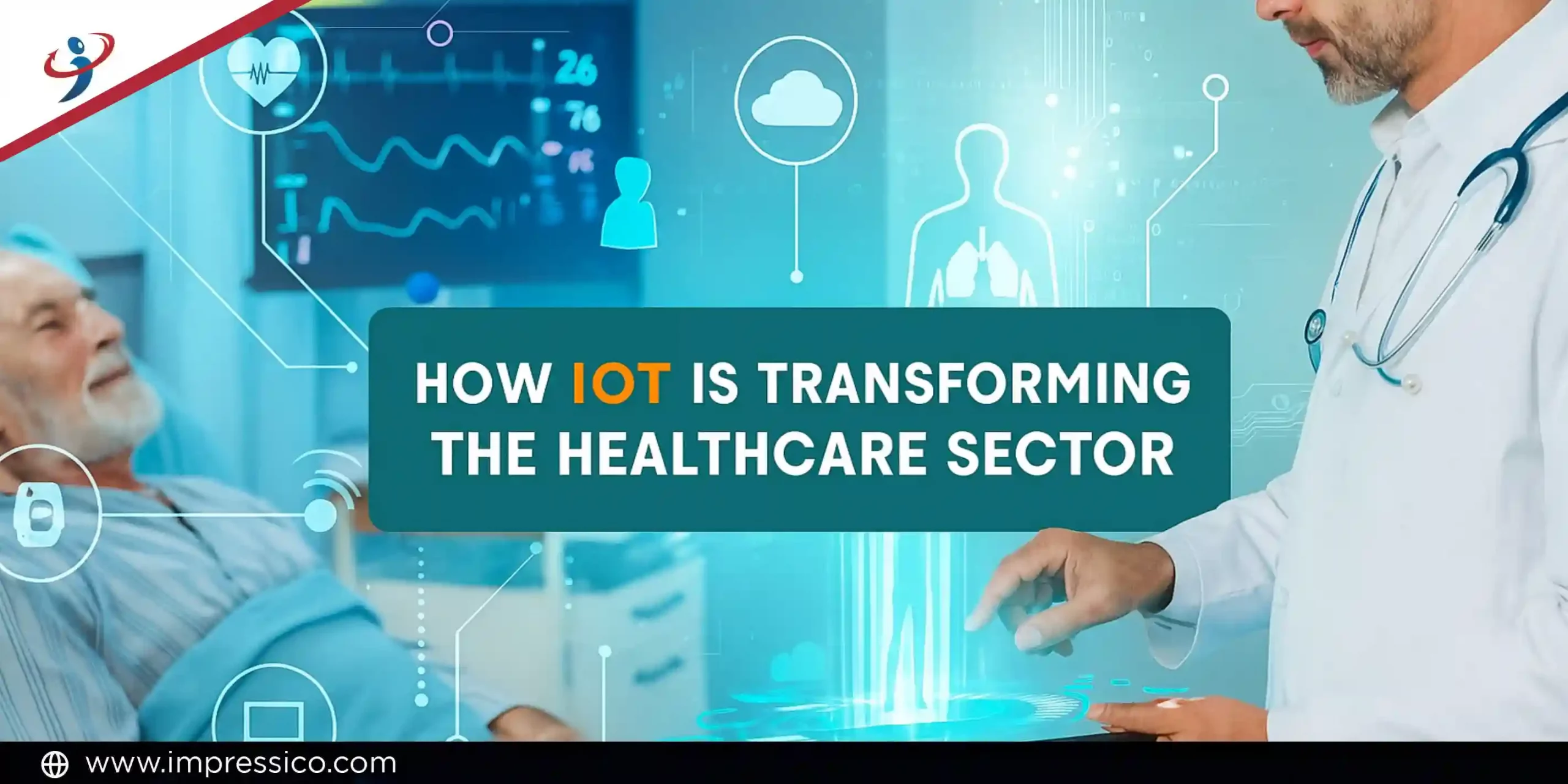
Table of Contents:
- Introduction: IoT and Healthcare Transformation
- What Is IoT in Healthcare?
- Reasons to Use IoT in Healthcare
- Remote Patient Monitoring (RPM)
- Smart Hospitals and Digital Workflows
- Managing Chronic Diseases
- Medical Equipment Predictive Maintenance
- Improved Patient Experience
- Data-Driven Decisions
- Challenges and Security Concerns
- Cybersecurity Risks
- Preventive Measures
- The Future of IoT in Healthcare
- Conclusion: Digital Transformation and the Role of Impressico
The healthcare sector is undergoing a dramatic overhaul. Why is this happening?
It is the Internet of Things (IoT). From wearable health monitors that track heartbeats to intelligent hospital beds that monitor patient mobility, IoT in healthcare is transforming the industry at a record pace.
This IoT revolution in healthcare is no longer something for the future. It’s already here, all around us. Those who welcome IoT healthcare solutions are experiencing improved patient outcomes, decreased operational expenses, and streamlined systems.
Let’s dissect how IoT is transforming healthcare and what makes it so revolutionary.
What Is IoT in Healthcare?
The Internet of Things in healthcare is employing connected sensors and devices to gather, exchange, and analyze information in real-time. This may be sourced from patients, equipment, hospital settings, and so on. The aim is straightforward – enhance care provision and make healthcare more efficient, cost-effective, and individualized.
Reasons to Use IoT in Healthcare
Here are some obvious advantages and benefits of IoT in healthcare already having a significant impact:
-
Remote Patient Monitoring (RPM)
Picture being able to monitor your health without visiting the hospital every week. That’s what RPM makes possible. Patients are able to wear IoT-enabled devices such as smartwatches, glucose sensors, or heart-rate monitors. These devices feed data 24/7 to physicians.
-
Why It Matters:
-
-
-
- Chronic illness patients, such as diabetes or heart disease, require frequent visits to the hospital.
- Physicians receive precise information in real-time and can make faster decisions.
- It minimizes emergency room visits and readmissions.
-
-
-
The world market for Remote Patient Monitoring is projected to reach $175.2 billion by 2027 at a growth rate of 26.7% every year.
-
-
Smart Hospitals and Digital Workflows
Hospitals are getting smarter due to IoT. Imagine hospital beds that adjust automatically, temperature sensors that manage room climate, or medication trays that alert nurses when it’s time for a dose.
-
Benefits of IoT in smart hospitals:
- Fewer errors and quicker response times
- Improved resource management (staff, beds, equipment)
- Healthier and happier patients
-
-
Managing Chronic Diseases Better
Long-term diseases such as asthma, hypertension, or heart disease are chronic diseases that require constant attention. IoT facilitates providing this constant attention.
-
Example:
- An asthma patient can have a smart inhaler which tracks when and how many times an individual uses it. Then, it will alert the doctor if anything out of the ordinary occurs.
-
Benefits:
- Early alerts of possible emergencies
- Reduced hospitalizations
- More customized care plans
-
Impact:
- IoT solutions have cut asthma-related emergency visits by up to 60% in some research.
-
-
Medical Equipment Predictive Maintenance
Hospitals depend on equipment such as MRI scanners, ventilators, and surgical instruments. When these fail, it can postpone treatments or even risk lives. IoT assists in monitoring equipment in real-time and anticipating issues before they occur.
-
How It Assists:
- Tips off when maintenance is required
Decreases downtime and repair expenses
Ensures patients’ safety
- Tips off when maintenance is required
-
Predictive maintenance with IoT can cut downtime by 30 to 50% and extend the life of machines by as much as 40%.
-
-
Improved Patient Experience
IoT isn’t only about machines, it’s also about simplifying the healthcare experience for patients.
-
Examples of improved patient experience:
- Smart wristbands for hospital registration
- Pill reminders through apps
- Virtual health assistants based on AI and IoT
- When patients are more engaged and cared for, they’re more apt to adhere to treatment protocols and remain healthy.
-
-
Data-Driven Decisions
The vast amount of data gathered by IoT sensors can assist healthcare professionals in making informed decisions. It enables:
-
Health trends prediction
- Disease outbreak tracking
- Customization of care plans using real-time data
- This type of digital healthcare transformation is rendering treatment more appropriate and affordable.
-
-
Challenges and Security Concerns
Although the advantages of IoT in healthcare are apparent, there are certain risks involved. As more devices are internet connected, there’s a greater likelihood of cyberattacks. Personal health information is confidential and has to be safeguarded.
-
55% increase in cyberattacks in healthcare from 2022 to 2023, and most of these attacks were against IoT devices
-
What Can Be Done:
- Hospitals need to invest in robust cybersecurity
- Security must be embedded into devices right from the beginning
- Staff training and regular software updates are paramount
- Digital transformation in healthcare must always be accompanied by data privacy and security.
-
The Future of IoT in Healthcare
The future of healthcare solutions with the incorporation of IoT is rosy. Technology is getting cheaper and simpler to implement, so even small clinics will incorporate smart solutions. Picture this:
- You receive a health warning on your phone before you feel sick
- Your medication is regulated by your doctor according to your sleep cycles
- Virtual check-ups and automated therapy replace hospital visits
It’s not science fiction — it’s already underway.
Final Thoughts
IoT in healthcare is not a luxury, it’s a necessity now. The advantages of IoT in healthcare are improved care, less visiting the hospital, more precise treatment, and less cost. The digital revolution in healthcare is turning hospitals intelligent, physicians more knowledgeable, and patients more empowered.
We at Impressico are committed to being part of propelling this healthcare revolution. Our IoT healthcare solutions are designed to aid in remote care, enhance patient safety, and modernize conventional medical systems into contemporary, technologically enhanced healthcare networks.
Key Takeaways – IoT in Healthcare
- IoT connects devices and systems for real-time health data.
- Remote Patient Monitoring reduces hospital visits and improves care.
- Smart hospitals automate beds, climate, and medication workflows.
- IoT helps manage chronic diseases with smart devices and early alerts.
- Predictive maintenance minimizes equipment downtime and costs.
- Enhances patient experience via smart wristbands, reminders, and virtual assistants.
- Data-driven insights enable personalized care and trend prediction.
- Strong cybersecurity is essential to protect sensitive health data.
- Future includes automated therapy, virtual check-ups, and predictive alerts.
